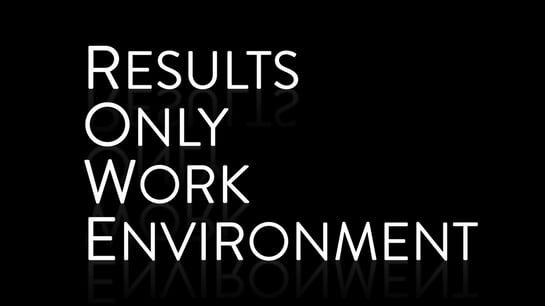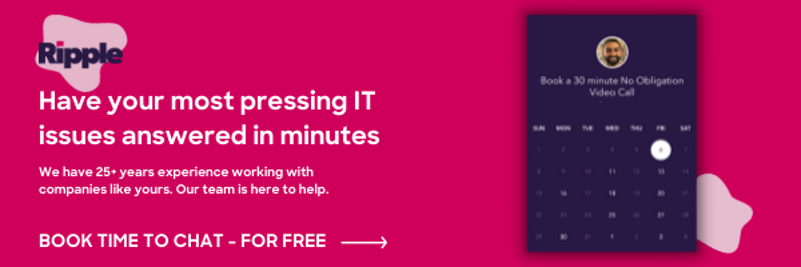
The way that people work has changed. Gone are the days where people are okay with being stuck in a cubicle from 9 to 5. Does this mean that it’s now harder to get things done? Not at all. It just will require a change in how companies approach their work environments.
Some companies are resisting adopting a remote or a hybrid workforce, but the truth is that shifting to a remote or hybrid workforce isn’t even enough. It’s not just where your team works that matters, it’s how your team works.
That's why at Ripple, we believe in the philosophy of a Results-Only Work Environment (ROWE) Long before the global pandemic and the shift to work-from-home, we've had ROWE as part of culture. And it's worked.
Going ROWE is a huge step and we're going to share some tips to make it successful.

Why should you listen to us?
Well, we implemented ROWE in 2007 and never looked back. It was a revolutionary ideology long before a global pandemic changed how so many companies worked. Even Inc. Magazine wanted to understand our process better. We were quoted in Inc. Magazine for an article focusing on the benefits of starting a business in Atlanta. Here’s a snippet:
“Some companies try a different approach to work around accessibility issues. Landman's Ripple is one of the companies that adopted a 'results-only' work environment, allowing employees flexible schedules so they can work from home or avoid rush hours. 'Here in Atlanta that's a huge benefit because the whole driving to work thing is a big deal for people,' he said.
Even if you don’t have the terror of Atlanta rush hour like we do, there’s still plenty of benefit in putting trust in your team and your leadership to have a flexible, employee-friendly, results-only work environment.
ROWE – The Philosophy
The Origin
For Ripple, ROWE came about because we were always looking for Work Utopia. We wanted people to be thrilled to do their work and leave at the end of the day with a sense of fulfillment, connectedness, and engagement. We had implemented many, many different things to try to create that Work Utopia and things were going okay. We managed with mixed levels of success.
As we grew, we put some policies into place, tried some new rules. Over performers on the team continued to do well, but we kept creating more and more rules for the under performers. Rules such as when to get to work, what constituted work, when to leave for the day. Productivity didn’t increase because of these rules and structures. It dropped. We were soon longing for the days where we didn’t need all this constricting structure.
When our team read Why Work Sucks, that was the eureka moment. We realized that everything we were trying to do to make our business run better was actually making work harder and less productive. The way that the traditional workplace was built assumed that there would be some great people, a bunch of good ones, and a chunk of poor performers that would need to be constantly managed. That needed to change.
The best team members don’t need to be micromanaged, they need tools and goals. And to attract the best team members, We needed the best work environment. An environment where the team could work remotely, have unlimited vacation, and not have to ask for permission every time they needed to run to an appointment. A workplace that cared about results, not presentee-ism.
We originally decided to try ROWE out for three months; we’re still doing it 15 years later. The results have been all we could have hoped for. Our productivity and profitability has skyrocketed. We do the same amount of work (and more) with 60% of the headcount. Our team is empowered and held accountable; team members are either getting results or they’re not. It may not be a Work Utopia (yet), but it’s a hell of a lot closer.
Why ROWE is Important to Us at Ripple
We love to share our experience with ROWE and how much Ripplers love it.
We believe that implementing ROWE can make a seismic cultural shift at any business. Here’s some reasons why:
- It is results-only. Focusing on results rather than rules is much more direct than focusing on the rules we use as proxies for results.
- No more checking in and checking out. Your team has the freedom to balance their own work/life responsibilities. Treating people as the adults they are is the respectful way to work together.
- Team members place more value in their work and feel a greater sense of ownership and responsibility.
- Early birds? Night owls? Who cares? ROWE allows people to self-assess and work at unconventional hours to make the most out of their most productive time of the the times where they’re the most productive.
Why ROWE Works
Although a lot of companies are starting to embrace ROWE, the majority are still afraid of commitment. They’re waiting to see if those adopting ROWE will succeed. Here’s some major other companies that use a ROWE philosophy:
- GitHub
- Lullabot
- Trello
- Toggl
- Pardot
You might be saying to yourself, “Well, that’s great for Ripple and those companies. But why would ROWE work for my business?” ROWE works because:
- It focuses on personal responsibility. It allows team members to do the actual work that they were hired to do. The team has more ownership over their roles, leading to more fulfilled and engaged team members.
- Teammates are trusted to get the job done wherever, however, whenever. They’re only judged by the result they get and the manner in which they conduct themselves.
- The team is full of the best people. They don’t need to be micromanaged. You don’t have to spend your day lurking around and checking in on whether they made it to the office on time. You save time and frustration because the best team members just want the freedom to do their jobs.
Want a free productivity plan developed by our years of experience in ROWE? Well, here you go.
Elements to a Hybrid/ Remote Workforce
Clearly, having a ROWE approach to your business doesn’t just mean that you’ve switched to a hybrid or remote workforce. There’s many ways that companies have transitioned to remote work that fully go against the spirit of ROWE by adding in lots of extra processes and unnecessary steps or check-ins. That being said, the flexibility of a hybrid and remote workforce is an attractive element of a ROWE. You just have to do it right.
Pros and Cons of Hybrid/Remote Workforce
Don’t expect to tell your team that they can work from home and see results overnight. It takes time to get everyone on the same page and there’s always going to be some pros and cons with remote work. But if you address the issues early and empower your team, those speed bumps will soon be a distant memory.
Pros
- You can attract the best: The best and brightest workers love working for companies that love and appreciate them and give them the freedom to succeed. They’re not looking for a job where they’ll be chained behind a desk from 9 to 5. If you can allow your workers to telecommute, you have better chances of attracting a better-quality talent pool. You no longer have to look only at your backyard for the best candidates. The whole world is now your talent pool.
- Your team will have the freedom to innovate: By creating an environment where the mind can roam freely, create, and innovate, you have better chances of encouraging inspiration and breaking down barriers. Sometimes things like taking a stroll, being in the comfort of your home, or even going down to the coffee shop can trigger your creative juices.
- Better productivity: Team members with a fulfilling work and life balance will be more energized and productive. If they feel like their work matters and their personal time matters, they will have a greater dedication to helping you and the rest of the team succeed.
- Better investments – A mobile workforce reduces certain overheads like maintaining a physical location, heating, furnishing, and office maintenance costs. Plus, it keeps costs down for your team members who are no longer commuting (and let’s not forget the lowered stress levels from avoiding the morning and evening commute traffic).
Cons
Managing a remote workforce won't be smooth sailing – that would be too easy, right? There are some pitfalls you might experience along the way. But with proper planning, you can mitigate and reduce the risks drastically.
- IT security: With all your team members under one roof, managing IT threats is as easy as fortifying the borders around the office. In a remote or hybrid environment, maintaining IT security is vastly different because the employees are spread out. You still can do it - there’s just certain steps you should take such as implementing two-factor authentication, zero-trust (yes, we see the irony here), and other cybersecurity measures.
- Office communication: In an office setting, communication can be easy and informal. Important conversations flow freely and naturally when the staff is taking a break around the coffee machine. In a remote environment, getting those conversations flowing is different because operates in their own isolated physical space. You can address this by using tools like Zoom and Slack that will allow your team to communicate and coordinate on projects. Try having a few Slack channels that are “just for fun” to encourage some of that old school water cooler talk.
- Productivity: When IT security and communication are not clicking, productivity will falter. Having a qualified and effective service provider (hey, that’s us!) and encouraging your staff to share their concerns can help get productivity back on track.
Technologies and Tools
Technology is a significant part of going ROWE. Technology simplifies the process, eases communication, and improves a variety of other aspects of a remote or hybrid workforce. Some essential technologies and tools that will make a difference and make the transition smoother include:
- Quality Internet Access: Having fast and reliable internet is a key component of an effective remote work set-up. Whether it’s access to a 5G wireless network or gigabit fiber broadband, it’s never been as easy to have fast, secure, and reliable internet access. Your team shouldn’t be spending their time worrying about dropped Zoom calls or poor connections.
- Video conferencing: Team collaboration is critical to the success of a remote work setting. Luckily there are a plethora of solutions that make communication and virtual meetings easier like Zoom, Teams, and GoToMeeting.
- Team communication tools: For team collaboration, you have tools like Microsoft Teams, Slack, and Chanty that let you keep up to date with team members.
- Productivity and automation tools: Managing remote work is made easier using tools that help optimize schedules, enhance performance, and improve efficiencies like Trello, ClickUp, Wrike, Asana, and Miro.

Security
Moving to remote work means restructuring your IT security approach. Your team is no longer in one central location where you have full control of the systems. Even in a hybrid setup, you’ll likely have people going in and out of your location at various hours; that shouldn't mean that you compromise security. There are methods and tools you can use to maintain high-level security and fluidity in work. Some critical security tips you can use include:
- Ensure all employees use the approved cloud applications that your company can properly secure
- Use strong endpoint security software for you and your employees to prevent cyber attacks
- Implement a Zero Trust model rather than a traditional VPN
- Use Multi-factor Authentication to add an extra layer of security (everywhere you can, but START with email, this is the most vulnerable system)
- Update software and hardware regularly
- Automate backup to prevent loss of data in case of hardware failure
- Train your employees regularly on the dangers of security lapses and how to prevent them
Maintain the Culture
Getting your remote or hybrid team up and running is the easy part. Maintaining the culture takes a lot more effort to make it work - and it’s incredible when it does.
The three key areas you should focus on when working to maintain culture in a ROWE are:
- Adapting: You're going to face unique challenges along the way. You just are. There’s no shift in a company that doesn’t come with speed bumps. You have to adapt and be flexible as you go to continue doing what’s best for your company, your team, and your customers. When people know you’re in it together and the company is listening, it can be a fun journey.
- Employee satisfaction and reporting: Ensure your employees are happy! Give them the ability and confidence to share their concerns. Encourage them to share their wins with the team. Listen to how they think the company could improve.
- Recruiting and onboarding: Have criteria for recruiting and onboarding new employees so they are integrated into your company culture seamlessly. Teach them what they need to know and help them get situated. Establish checkpoints throughout the onboarding process - including time to get to know individual members of the team.
Shifting to ROWE at Ripple was the single best choice we ever made. It’s worked since 2007 and it’s made a great impact on our business. It’s results-oriented, after all. Want to learn more about Ripple and ROWE? Reach out to us!
Want to work with a managed IT service provider that understands ROWE and remote work? Partner with us for managed IT services. You can start your journey by having a 30-minute consult with a member of our team.
Don't Fall Behind!
Get the latest work-from-home and Humans First® IT tips straight to your inbox.

